When writing my field report on the 10mm GP100, I was ridiculously curious about the ballistics of the 10mm cartridge from a revolver. Lacking a suitably-chambered auto-loader with which to compare velocities, I reached out to Ruger and asked for a 10mm SR1911. They obliged, and within the week I had slab-side in BestMM sitting beside the GP100. I used it to do side-by-side velocity comparisons with the GP100, and I decided to review it on its own merits.
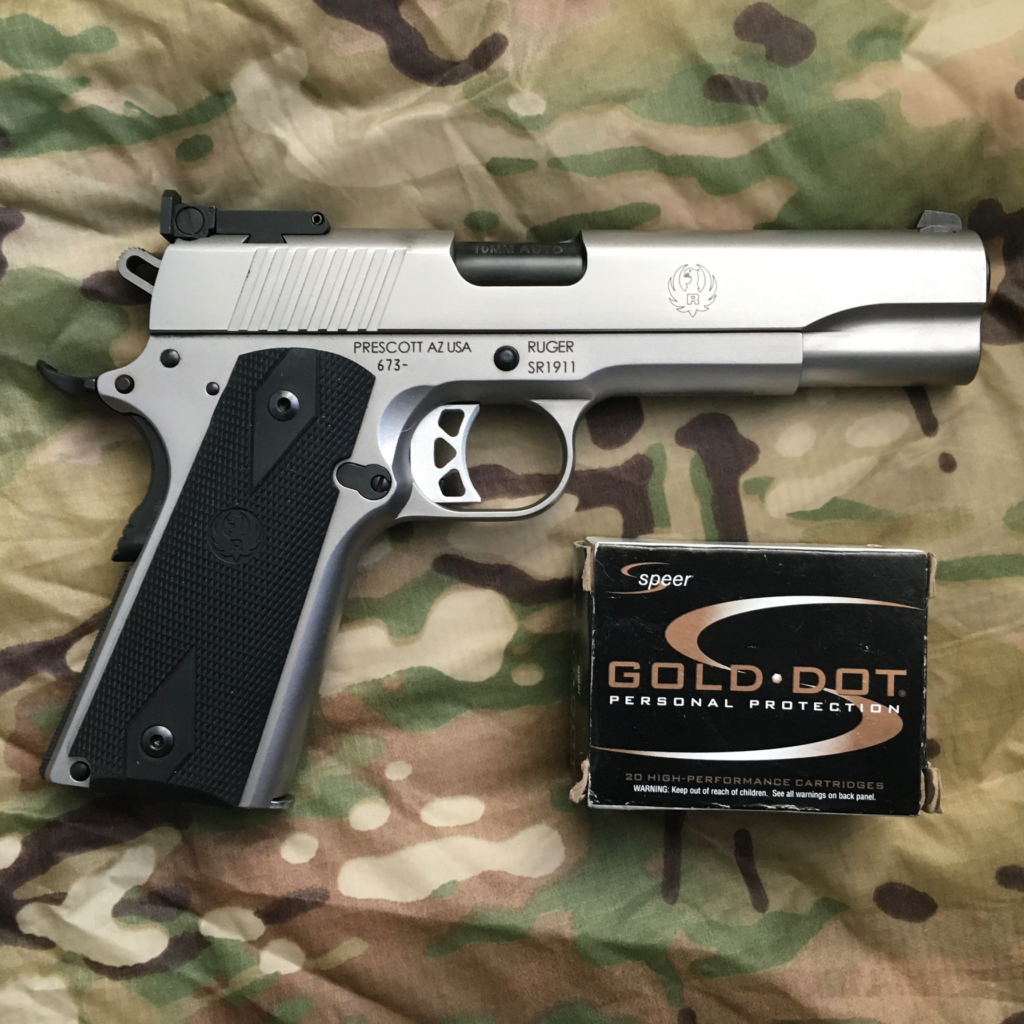
Ruger 10mm SR1911
The primary components of the Ruger 10mm SR1911 – the frame and slide – are CNC machined from stainless steel. While at Ruger’s Prescott facility I remember picking up a massive piece of bar-stock steel and admiring its heft. Our tour guide looked at me and said, “there’s a 1911 slide inside of that.” That set my expectations of Ruger’s 1911s pretty high. Unlike Ruger’s Match Champion guns, the slide of this 1911 is relatively unadorned. The right side bears a very simple Ruger logo and the left a stately, “RUGER, MADE IN USA”. The slide also lacks forward cocking serrations, a feature I generally demand, but the lack of which does contribute to a clean appearance.
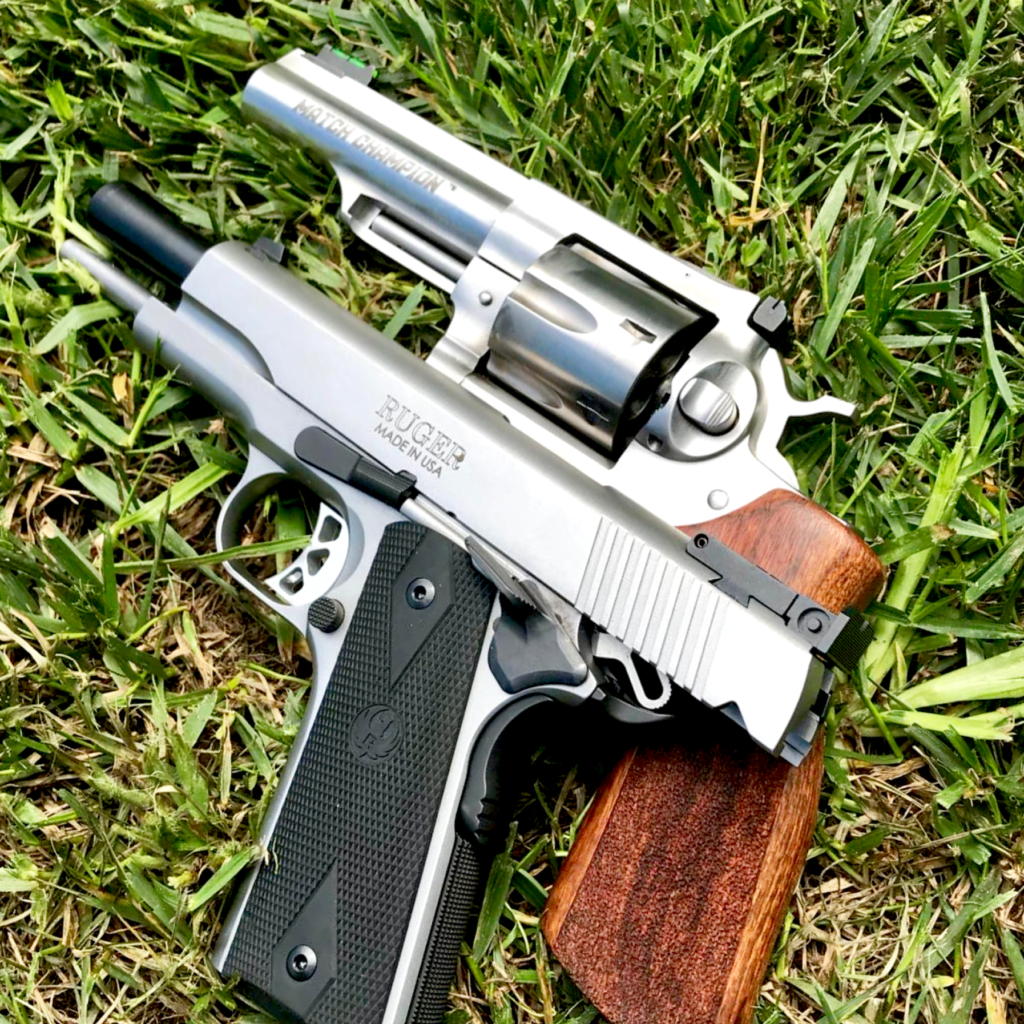
Ruger chose to use a coned, bushingless barrel and full-length guide rod on the SR1911. I don’t have strong opinions on bushingless barrels or full-length guide rods, so do with that information what you will. The sights, slide stop/release (as one pleases), safeties, barrel, and mainspring housing are all black. Combined with the very usable black rubber grips, this is a handsome, two-tone gun that doesn’t look overdone.

Overall the quality of the 10mm SR1911 is good. The slide-to-frame fit is good for a production gun, and slide travel is exceptionally smooth. The trigger pull is crisp, and comes in right around 4 pounds with a short, sharp reset. Close examination reveals that this is no custom gun, however. The fit of the trigger is particularly loose, with a lot of north/south play. The fit of the thumb safety is not particularly tight, either. Disengaging the safety has a mushy feel but a nice, audible/tactile “click.”
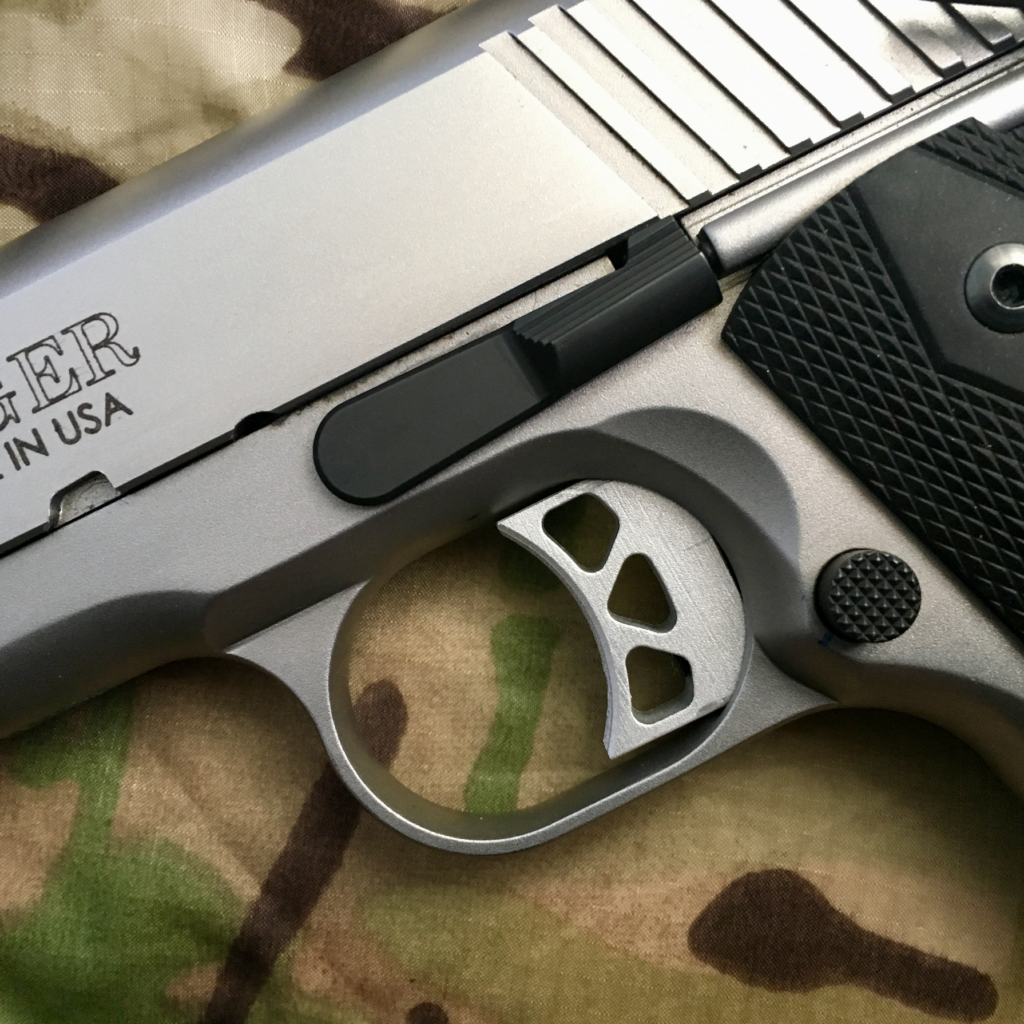
Additionally, the grip safety, and some other small parts could certainly be better, but again, this is a production gun at the low-mid end of the 1911 price spectrum so I’m willing to accept some trade-off. The remainder of this review will utilize Mike Seeklander’s R.E.A.P. methodology. I will examine the 10mm SR1911’s Reliability, Ergonomics, Accuracy, and Power.
Reliability
The 1911 is rather infamous for being a finicky eater. This problem seems to be exacerbated when one veers from the beaten track and deigns to chamber a 1911 in something other than .45 ACP. With this in mind I was prepared to experience a few malfunctions. On my first range day with this gun I ran a pretty broad selection of ammunition over a chronograph for my GP100 field report. At the end of the session I realized I had fired approximately a hundred rounds, in a variety of bullet weights and styles, from all over the power spectrum and the gun had worked flawlessly.
So I decided to up the ante. I assembled the odds and ends of various boxes of ammo. I put together four magazines’ worth of mixed loads. Each magazine contained bullets ranging from 100 to 230 grains. Bullet styles were equally mixed: I loaded everything from big JHPs to wide, flat-nosed lead, and even the Lehigh Xtreme Penetrator. I stuffed the first magazine and emptied it as fast as I could. Every round fed, extracted, and ejected as intended. So I repeated the process with the same result. Then I loaded both mags to capacity again and repeated the whole thing. I couldn’t even get the gun to stutter. So far so good!
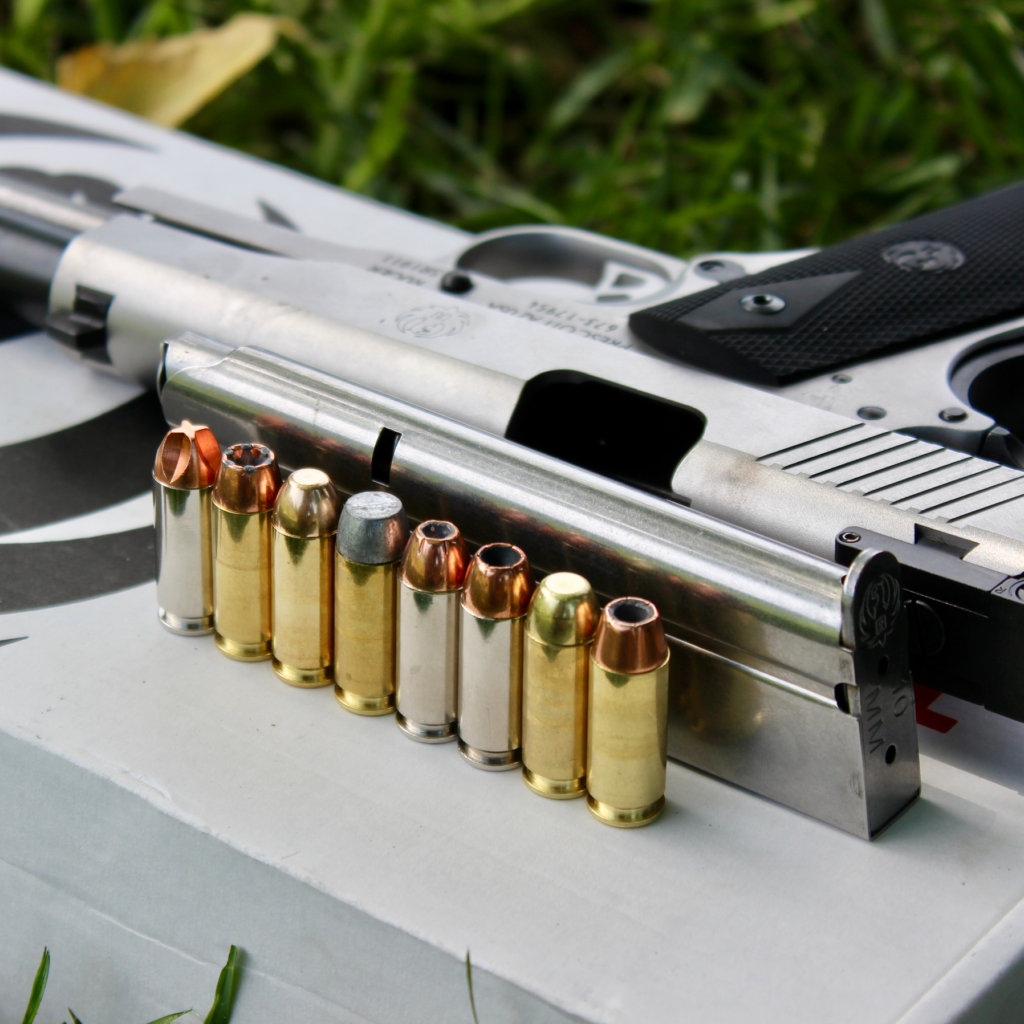
The next step was to shoot a lot of ammunition through the 10mm SR1911. I’ll admit that I didn’t do as good a job at this as I would have liked to. We’ve been reviewing a lot of guns here at RevolverGuy lately, and we have to buy all our own ammo. And by “buy our own,” I mean out of pocket – not from some deep corporate fund. The 10mm SR1911 got short shrift from my 10mm supply, but I did manage to put about 350 rounds through it over half a dozen range sessions. As with the GP100, loads fired ranged from mild to wild, from Federal American Eagle to the hottest stuff Underwood and Double Tap can field. The lion’s share of this ammo was Remington’s 180-grain FMJ.
During the entire testing I only had two malfunctions. For the first one, I can’t say I blame the gun too much. I had loaded up a full magazine of Double Tap 230-grain WFNGC. This bullet has a very flat profile and a very wide meplat – it’s about as close to a true wadcutter as you can get in 10mm Auto. On the third round out of the magazine, the slide failed to go into battery. The edge of the meplat caught up on the feed-ramp. After verifying that I hadn’t inadvertently activated the slide stop lever, a quick “slingshot” corrected the issue.
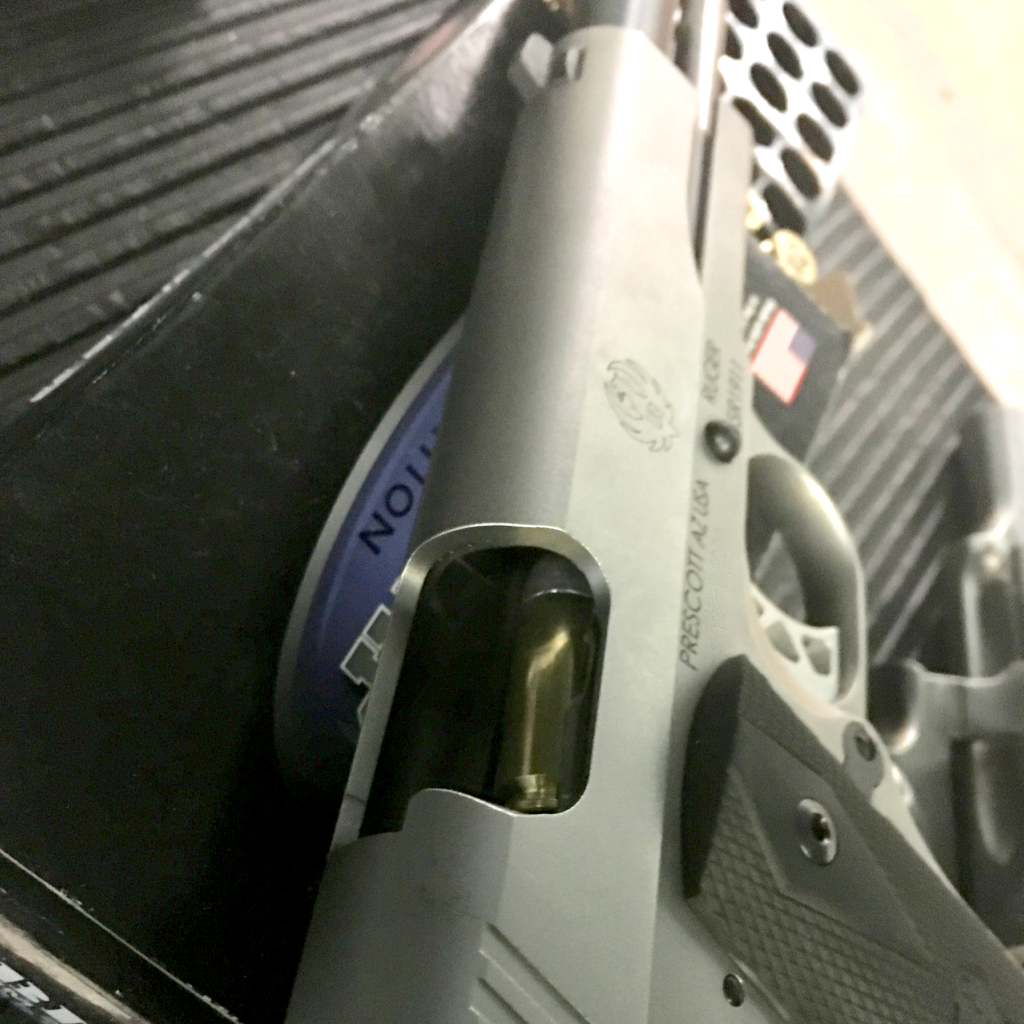
The second malfunction I had was a simple failure of a magazine to lock activate the slide-stop lever. This isn’t ideal, but to me it also isn’t a show-stopper. The only maintenance performed during this test was around the 150-round mark; I added a couple drops of oil to the the slide rails. Overall I am pleased with the reliability of the 10mm SR1911, provided the end-user tests his or her desired ammo/gun combination to ascertain reliability.
Ergonomics
There are a number of factors that contribute to the nebulous “ergonomics” category. This gun is a standard sized 1911, so its general ergonomics should be familiar to most readers familiar with that platform. There are a few specifics I’d like to include here, however.
The first is the one I feel is most important for a gun of this style, and especially in this caliber: the front-strap. The SR1911’s front-strap is smooth. I believe a checkered or otherwise adulterated front-strap to be imperative to controlling the 1911-style handgun. A major percentage of one’s grip is obtained on the front-strap of the gun, and a smooth surface allows precious little purchase. I realize that this is a reasonably-priced handgun considering its quality and caliber, and such modification would raise the price, but I feel that it would be well worth it. In the absence of such a modification, a little front-strap tape from the likes of VZ Grips would go a long way.
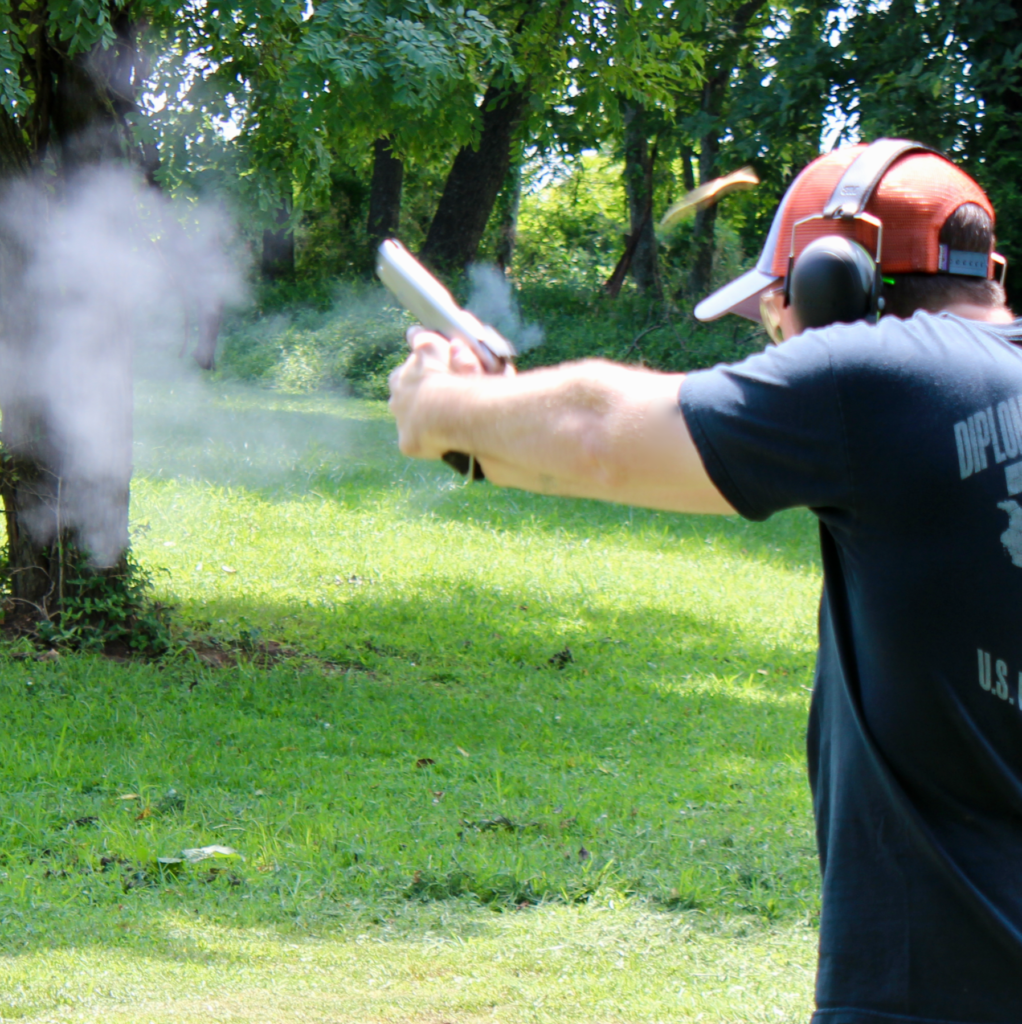
The next 1911 modification I find essential, at least in a defensive firearm, is an ambidextrous safety. I believe this is a relatively inexpensive modification, and feel it should be included on this one. That said, with its target sights the 10mm SR1911 doesn’t seem to be marketed as a defensive handgun, so you may be willing to overlook this omission, or install your own.
The 10mm SR1911 extracted its pound of flesh from this writer. Well, maybe not flesh, but it did draw a pretty exciting amount of blood. When slamming a magazine home, the heel of the magazine caught the fleshy portion of my palm. The magazine seated fully, capturing both the mag, and the palm of my hand in the gun, creating a pretty big cut in the heel of my hand. If this gun were mine I would invest in some magazines base pads to prevent this from happening.

Otherwise, the ergonomics of the 10mm GP100 were pretty standard. If you like the feel of a 1911 in your hand (and I do) you’ll like this gun. Being all-steel and full-sized, this is a pretty heavy gun. Considering its most likely use cases, hunting, woods defense, and target shooting, this should be just fine.
Accuracy
The sights on the 10mm SR1911 are outstanding. The rear sight is an adjustable target model. The blade is wide and distinct, and horizontally serrated to minimize glare. The front is a simple black blade. Though some don’t care for them, I appreciate simple black-on-black sights for accuracy work. I also deeply appreciate the ability to move point of aim to match point of impact. The handful of 10mm loads I fired exhibited drastically different points of impact, depending on bullet weight and velocity.
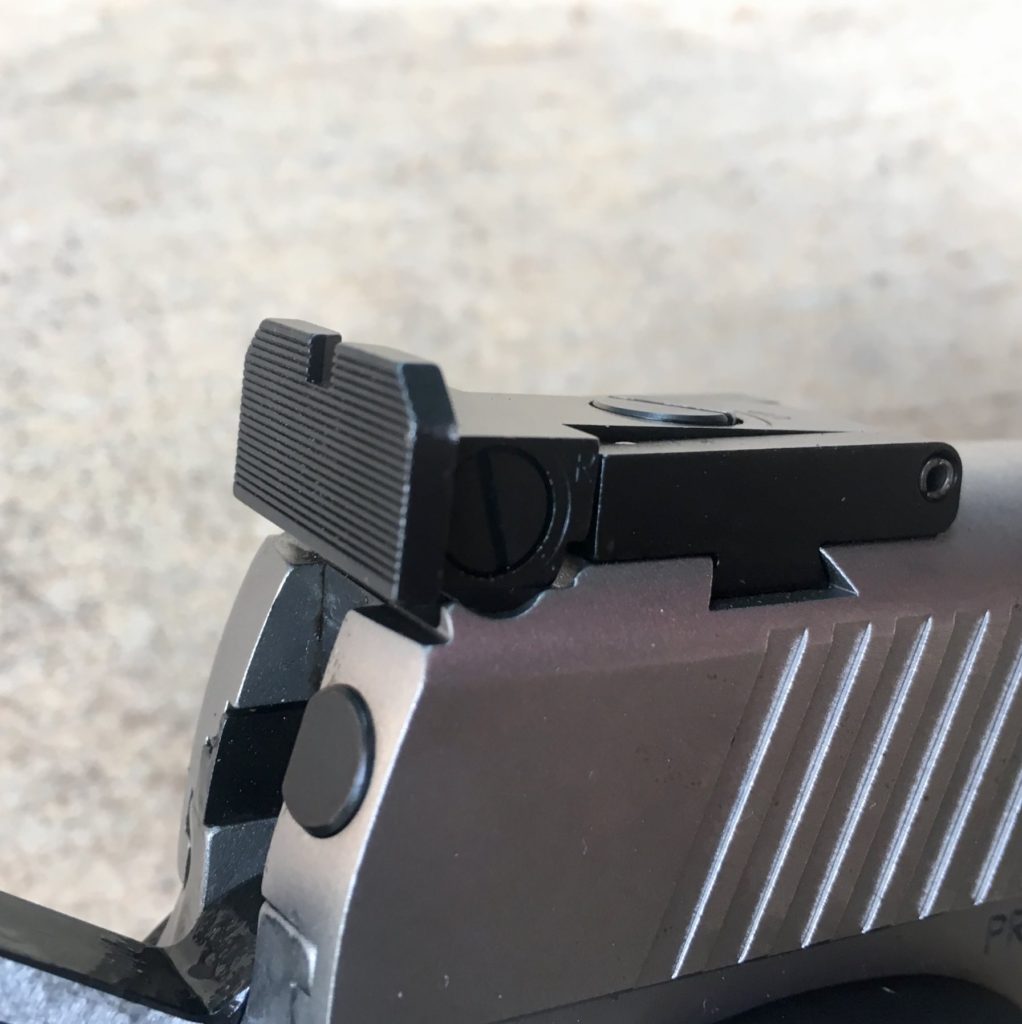
I didn’t test the accuracy of the 10mm SR1911 to an exacting standard. This was partially due to the cost of acquiring a sizeable sample of 10mm ammo, and partially due to time constraints. However, I believe the 10mm SR1911 to be capable of excellent accuracy. The most exacting test I subjected this sample to was fired on a NRA 25-yard slow fire pistol target. I loaded up a full magazine and ran the target out to 50 yards. At that distance I was easily able to keep all eight rounds inside the 5-ring. Just to ensure this wasn’t a fluke I shot the same string of fire twice more with the same result. A more capable shooter would doubtlessly be able to best my results in the accuracy department.
Power
It should come as no surprise that I consider power to be a clear-cut “affirmative” in this handgun. I will compare the 10mm with three other popular defensive calibers: .357 Magnum, .40 S&W, and .45 ACP. The 10mm velocities listed are actual velocities that I captured. Velocities for other calibers are those collected by Lucky Gunner during their ballistic gel test series. This isn’t exactly an apples-to-apples comparison, but I settled on these because I wanted to compare bullets of similar weights. Each bullet in .357, .40, and .45 is the fastest bullet in its weight recorded by Lucky Gunner.
|
.357 Magnum vs. 10mm Auto – 100-grain Bullet |
|||
|
Caliber |
Bullet |
Velocity |
Energy |
|
.357, 4” |
1364 |
413 |
|
|
10mm |
100-grain Underwood Xtreme Defender |
1778 |
702 |
|
.40 S&W vs. 10mm Auto – 180-grain Bullet |
|||
|
.40 S&W |
995 |
396 |
|
|
10mm |
1192 |
568 |
|
|
.45 ACP vs. 10mm Auto – 180-grain Bullet |
|||
|
.45 ACP |
908 |
431 |
|
|
10mm |
230-grain Double Tap WFNGC |
1085 |
577 |
The 10mm obviously has power aplenty, but this power comes at a cost: stiff recoil. Whether or not it is desirable is at the end-user’s discretion. Were I considering the purchase of a firearm for defensive purposes, I would probably reach the same conclusion Chris reached during Lucky Gunner’s 10mm gel test: most of the 10mm’s extra gas is probably wasted for defensive use. Were I considering a handgun for long-range work, hunting, or animal defense, the 10mm SR1911 would definitely be in the running, however.
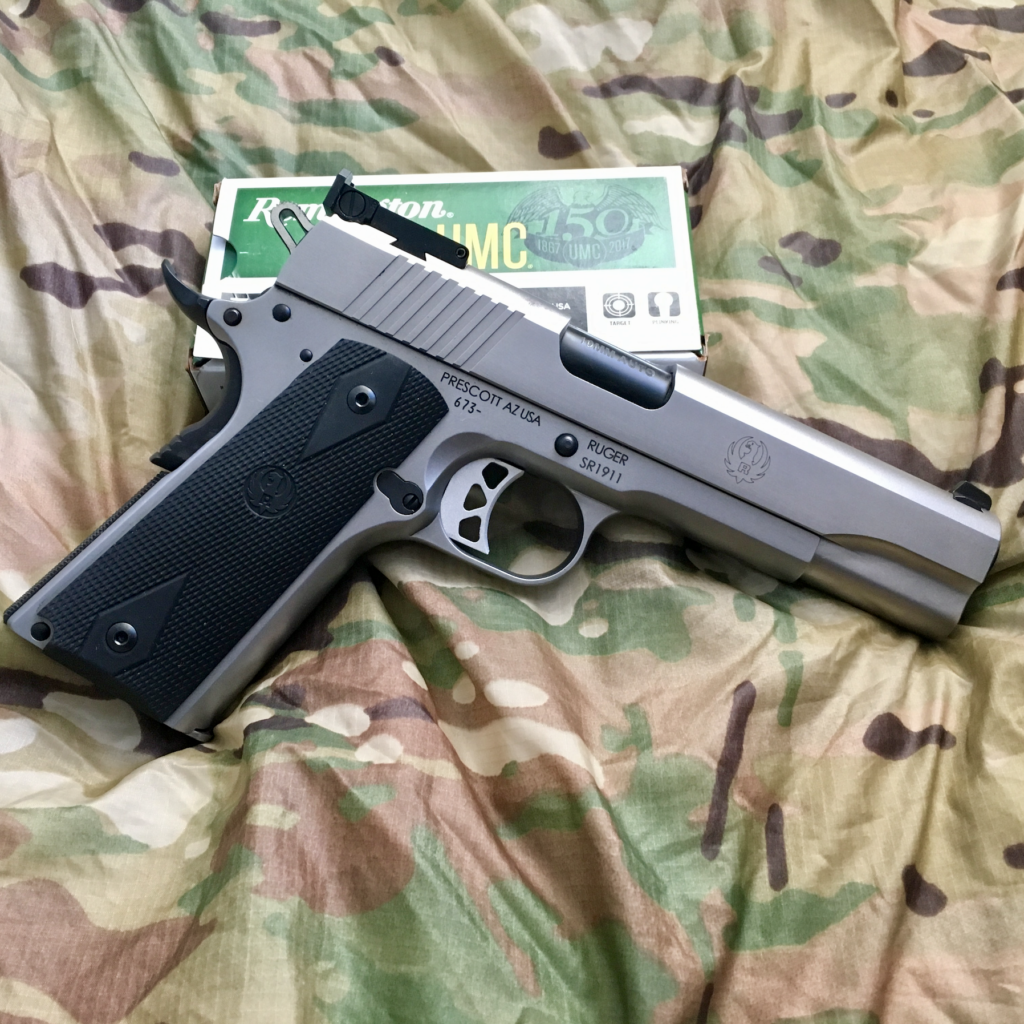
The Bottom Line
It’s no secret that I’m a fan of the 10mm Auto, for better or worse. In fact, I wrote an article entitled “State of The 10mm” for American Handgunner almost a decade ago, back when only a handful of manufacturers were making 10mm ammo. The list of manufacturers making guns in 10mm was even shorter. It should also go without saying that I’m a 1911 fan. To me the proliferation of affordable, production 1911s in 10mm is truly a dream come true.

The 10mm SR1911 is at the top of my list for an autoloading 10mm. Though it isn’t the flashiest gun around, it works really well and at a really comfortable price point. At an MSRP of $1019 (and real market prices around $800), the 10mm SR1911 is extremely competitively priced. If you’re a 1911 Guy, or a 10mm Guy…or both, give this one a serious look.

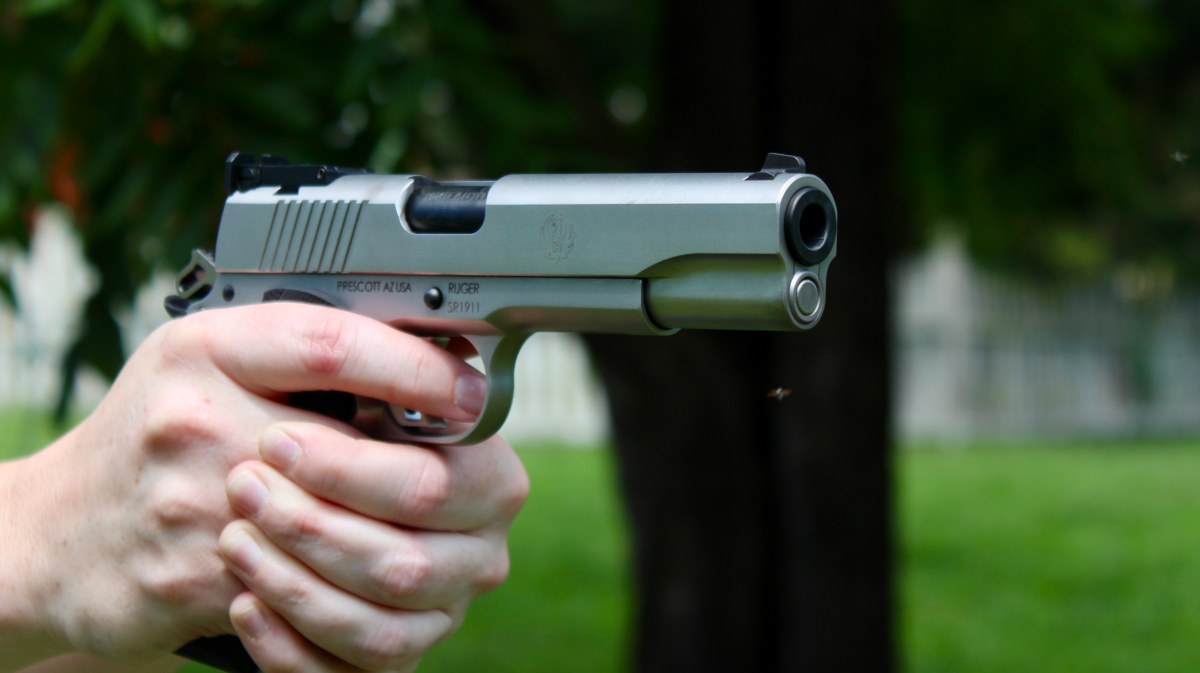
It’s more powerful than I need, though I love 1911s. I will stick to .45. I am the same with wheelgun, finding .44 magnum fun but impractical for my uses.
I love a smooth slide and an unadorned design on a 1911. Ruger did well with the minimalist look, though a smooth front strap must have made the thing a handful to shoot.
I understand that, if you were purchasing a gun for defensive purposes, you’d opt for something different. However, if for some reason you decided to use this 10mm for defensive purposes, what ammo would you choose?
I ask because I’m looking at 10mm ammo for defensive uses, and am having a difficult time choosing something. I’m not going to opt for over-powered boutique ammo because I don’t believe that is necessary or even beneficial, but it seems to me that most of the moderate powered 10mm ammo seems to be an older version of 40 S&W ammo.
For example, Federal’s 180 grain Hydra Shock has about the same velocity as the 40 S&W version, but 40 S&W defensive ammo has come a very long way since 180 grain Hydra Shocks.
I wish someone offered a 165 grain high tech bonded hollowpoint in 10mm at 40 S&W velocities.
Thanks for your blog and your articles. I always enjoy them.
Joe, Federal has announced a new 10mm load in their excellent HST lineup. The load will offer a 200 grain HST bullet at 1130 fps muzzle velocity. This will be one to watch.
Speer offers their 200 grain Gold Dot at 1100 fps, which is also a strong performer.
Around the same ballpark, you’ve got Winchester Silvertip (175 grains at 1150 fps) and Hornady Critical Duty (175 grains at 1050 fps).
I’d be happy with any of those for the self-defense mission, although they have a little more juice than you seem to be looking for. That’s just the nature of the 10mm though.
Doubletap offers a 165 grain bonded JHP, but it’s a little fast for your tastes at 1400 fps from a 5″ barrel.
Joe,
I agree with Mike that the HST is probably going to be a phenomenal performer (like the rest of the line!). I’ll follow up a little bit on what Mike said about the Gold Dot: I have shot the Gold Dot and if you’re running a full-sized gun, it’s not bad in the recoil department. I agree with you that the boutique stuff is unnecessarily hot, but the Speer load should be just fine for most shooters.
Even though I won’t use this gun as a primary defensive arm, I will lay in some Gold Dots or HSTs. You know…just in case!
Hope that helps!
Joe, I got the chance to shoot the 10mm HST in a 5″ steel 1911 this week and it was VERY manageable. I think you’ll like how that load behaves.
PLEASE, I respectfully ask, STICK TO REVOLVERS! I have no interest in reading about any semi-auto firearm on this website.
Sincerely,
David
CW3, USA (Ret)
Thanks for the input, David. You’ll notice that the SR1911 article was run as an extra, on a Tuesday. We do that occasionally to talk about other things that we’re interested in–or that our readers might be interested in–but our coverage remains overwhelmingly focused on revolvers. Our mainstay Saturday lineup is all about revolver stuff, and we hope that you’ll continue to enjoy that. If you don’t like the occasional extras, just check us out on the weekends!
Thanks for reading.
Mike is a little more polite than I’m inclined to be. I pay 100% of the bills for this out of my own pocket, and to put it bluntly – I’ll write about what pleases me. If you don’t care to read content like this, just don’t read it. It’s not as though a revolver article is getting scrubbed from the calendar because this appeared.
Respectfully,
Justin
In addition to what Mike and Justin have posted, I would like to mention that input about the decision to include semi-auto’s, camping stoves, knives, and other non-revolver content was solicited from the readership at that time. The overwhelming majority were in favor of non-revolver content and even those where were not truly in favor simply responded with comments to the effect of, “Go for it; I’ll just ignore the non-revolver stuff.”
Then do not read it problem solved -very simple -I myself really like 1911s have several and 10mm too! This sR in 10mm earns a serious look in my book ;an interesting addition to Rugers lineup!
Thanks Justin and Mike for your responses on 10mm ammo. I will keep an eye out for that new 200 grain HST, and will look into the Speer and Silvertip loads as well.
As a frequent reader, and a frequent listener when you guys appear on podcasts, I just want to say thanks for all you do. My focus in firearms leans heavily towards revolvers (primarily magnums), but I always enjoy the articles you do on other other firearms and other topics.
I think it’s important not to get too myopic about ANY particular format of firearm for defensive purposes. They are all worthy of consideration, and keeping in mind the particular goal (effective, reliable, concealable self-defense), I am always willing to re-evaluate what firearm will have my focus and attention. Your occasional articles on other firearms help me do that.
Nice, I especially like the full length guide rod. I know that’s controversial but I like them. I personally prefer an arched mainspring housing… Will it accept standard 1911 parts?